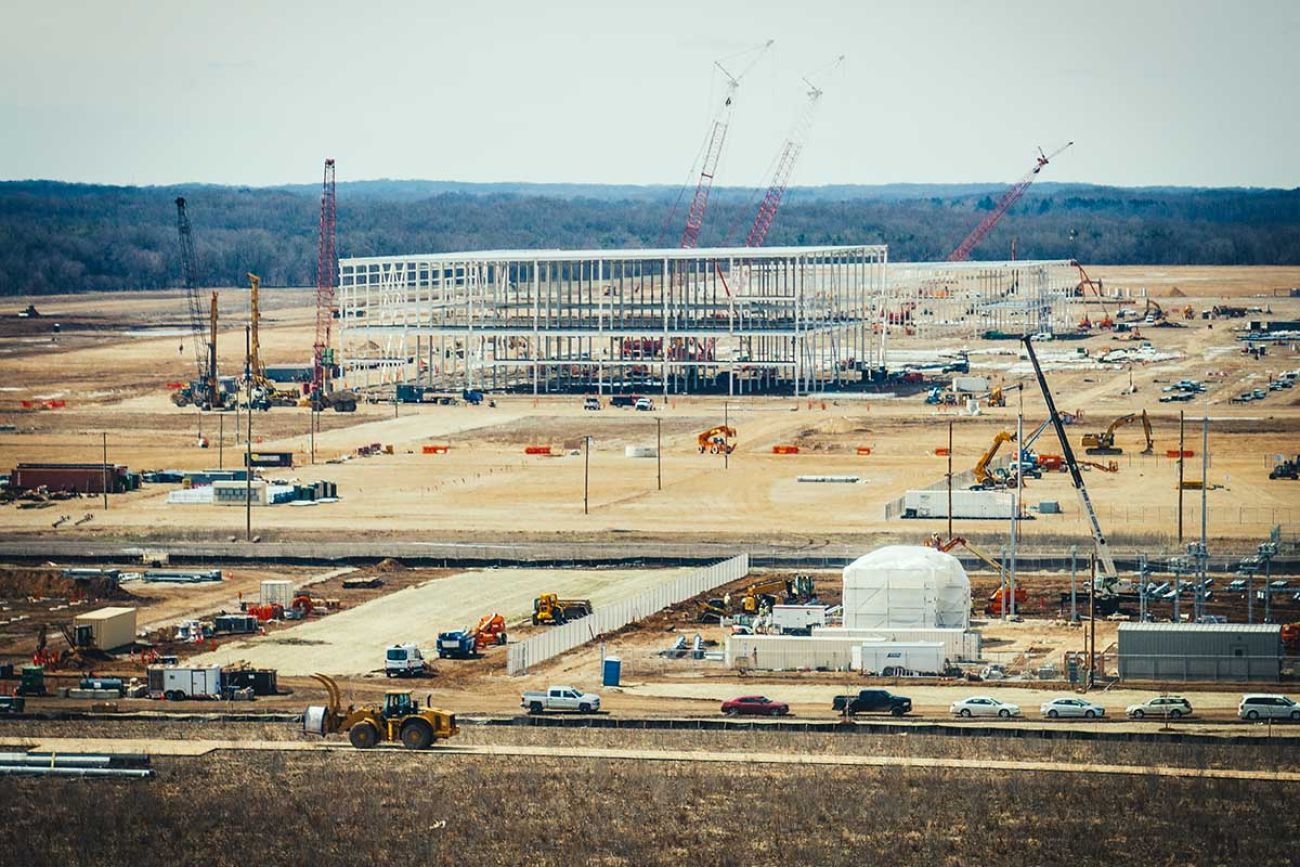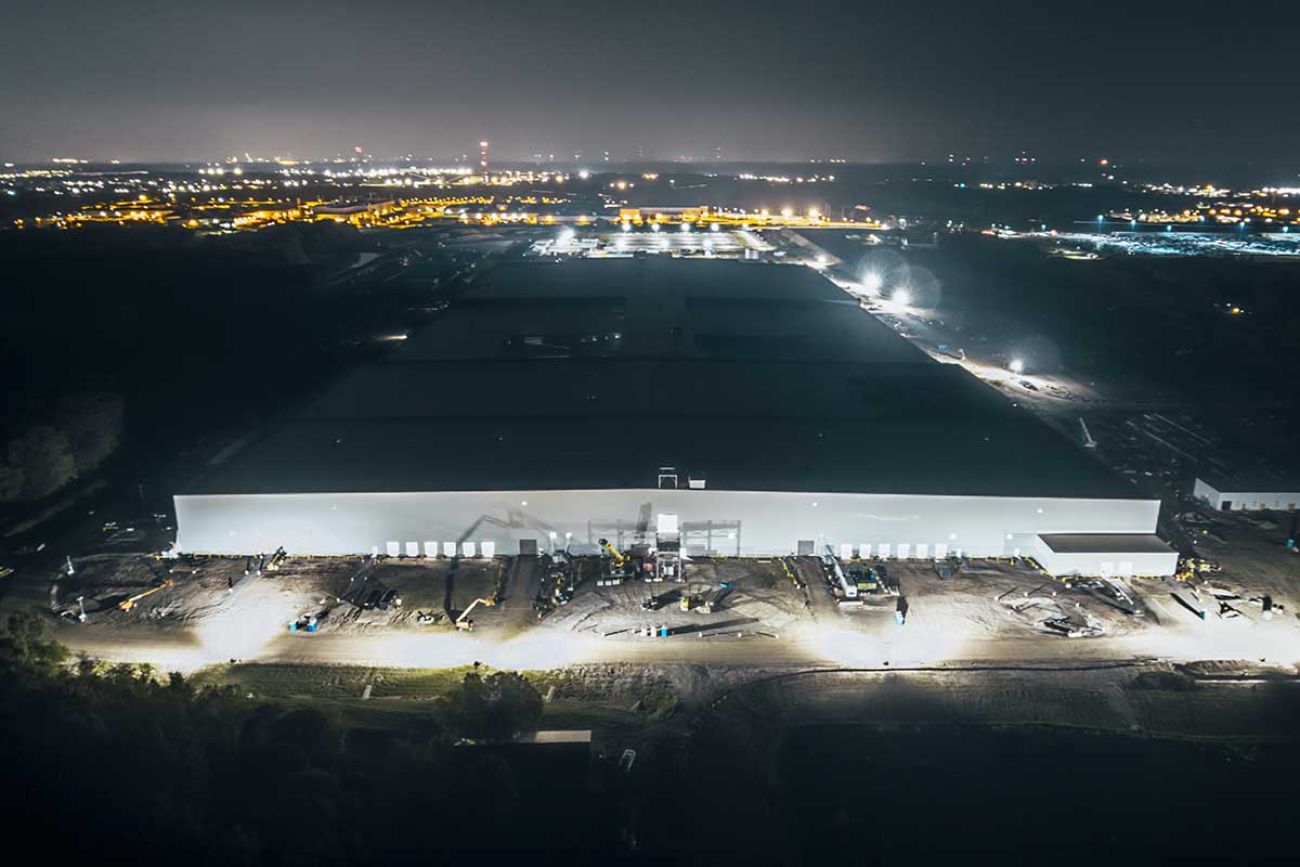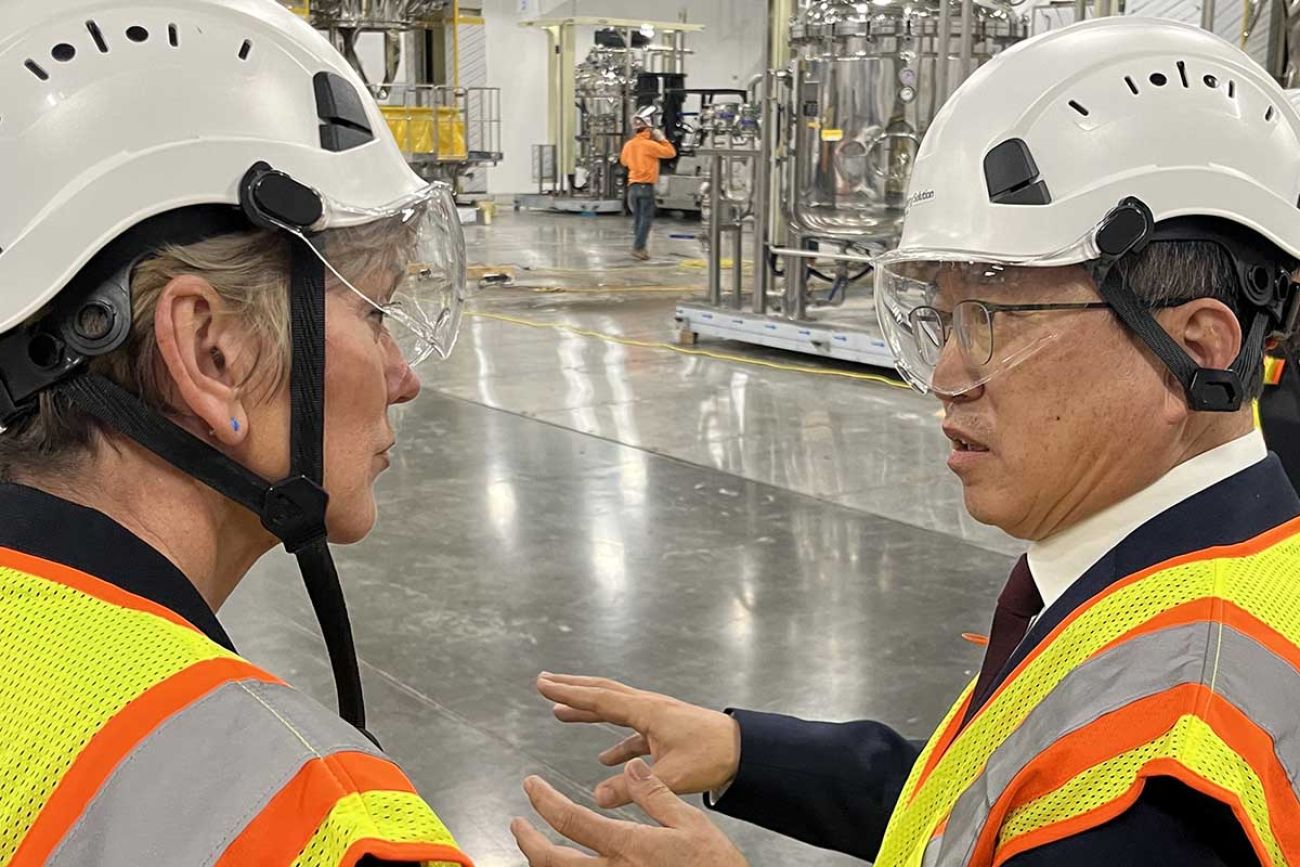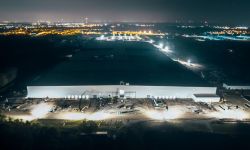Michigan has spent $1B on EV, battery plants. So far, they’ve created 200 jobs

- Michigan moved quickly to shore up its signature industry and discarded controls typically used in economic development
- The state has already spent $1 billion on EV and battery plants. Most are delayed or downsized
- The plants, which are years from completion, have created about 200 jobs
Michigan has spent $1 billion in corporate incentives and pledged hundreds of millions more for major electric-vehicle and battery projects that so far have created about 200 jobs, a Bridge Michigan analysis has found.
The payouts are a key plank in Gov. Gretchen Whitmer’s platform to make Michigan a leader as the auto industry transitions from combustible engines. But as EV sales underperform and the industry faces an uncertain future, Michigan has few guarantees the projects will follow through on job-creation promises.

The spending so far is roughly half of the $2 billion-plus Michigan has pledged since 2022 to five companies: Ford Motor Co., Gotion Inc., LG Energy Solution and Our Next Energy for battery factories, and General Motors Corp. for a battery factory and expanded EV production.
Whitmer announced the companies would invest $16 billion total and create 12,000 jobs. But all the projects are behind schedule and two have downsized, reducing best-case job expectations by 13%.
Bridge found:
- Two years after the subsidies, hiring remains at less than 2% of promises
- Should the projects under-deliver or fall apart, new rules could make it harder for Michigan to claw back money already spent
- The state paid at least $70 million to buy land for two of the gigafactories, payments that Michigan officials did not explicitly disclose
- Michigan spent another $78.3 million on one startup, Our Next Energy, that promised to create 2,112 jobs and invest $1.6 billion in an EV gigafactory. Instead, it has 50 workers at the project in southern Wayne County and laid off 25% of its company-wide workforce.
Auto manufacturing is in flux, and Michigan is in a fierce fight with southern states to keep its signature industry. Using public money has long been a key component of economic development, but Bridge’s findings pose questions about whether Michigan’s investment is protected.
And records refute claims from state officials that companies won’t receive money unless they meet hiring goals.

“The state of Michigan's risk with the change in demand is minimized because the money has been pledged … but the money hasn’t gone out the door,” Quentin Messer Jr., CEO of the Michigan Economic Development Corp. and a member of Gov. Gretchen Whitmer’s cabinet, told Bridge in late May.
That is not the case with the state's big battery and EV deals.
Bridge used the Freedom of Information Act to obtain records showing that Michigan has already given $51 million in loans and spent at least another $600 million on utility hookups and factory equipment, in addition to the land purchases for two of the five battery megadeals, Ford and Gotion.

GM has received at least $468 million of the state’s combined $600 million incentive promise for a battery factory in Delta Township and an expanded EV factory at Orion Assembly in north Oakland County.
Originally expected to open this year, both remain under construction.
Combined, the projects have hired 120 workers total out of the 4,000 publicly touted by Whitmer when the subsidy was announced.
However, neither Whitmer nor economic development officials clarified that Michigan in fact only required the automaker to deliver 3,200 jobs to get a subsidy and land-improvement package worth $666 million from the state.
GM won’t say when either factory may run at full capacity.
In Big Rapids, Gotion announced in August that it bought 270 acres near Big Rapids for its battery component factory.
Six months later, Michigan cut a check for $23.6 million to an economic development company, which then reimbursed Gotion for the land acquisitions.
Michigan paid about $88,000 an acre, records show.
Of the five projects, only LG Energy Solution Michigan in Holland hasn’t received a large up-front payout, documents show.
Whitmer's administration deferred comment to the Michigan Economic Development Corp. Its spokesperson, Otie McKinley, said the projects are still expected to have enormous economic benefit for the state, even with delays and incentives.
“While there has been some re-scoping, we are still talking about billions of dollars being injected into the state and thousands of jobs being created,” McKinley said.
‘Double risk’ for taxpayers?
The money for companies came through the Michigan Economic Development Corp., a semi-public agency, and was approved by political appointees on the Michigan Strategic Fund board.
In the case of megadeals, legislators only vote to release tax money once deals are worked out by the MEDC and the strategic fund.
They do not have a say in other incentives that can sweeten the package, including local tax breaks and road upgrades.

Patrick Anderson, CEO of the Anderson Economic Group in East Lansing, said Michigan is “taking big risks on the companies” and on “technology that was nascent and that still hadn't achieved anything close to widespread adoption.”
“That's a double risk that the taxpayers are taking,” Anderson said. “And one that I think policymakers should be more careful about.”
Related:
- Where mega battery, EV projects stand after $1 billion in Michigan subsidies
- Corporate subsidies cost Michigan $335M; 40% of deals create low-paying jobs
- In Michigan, 60% of jobs don’t pay middle-class wages. Can state stop slide?
- China making Detroit automakers 'underdogs' with huge EV push, experts warn
Electric vehicles represented 7% of all new U.S. car sales in April, a year-over-year sales decline of 4%, Cox Automotive analyst Eric Keating told Bridge.
Among the barriers to growth: Higher car prices and “range anxiety” caused by the slow rollout of public charging stations in Michigan and elsewhere.
Automakers such as Ford are losing $100,000 or more on each EV sold, regardless of the number of sales.
Advocates anticipate sales of EVs will jump in the next few years, especially with new emission rules under the Biden administration that attempt to transform the auto industry to mostly electric or hybrid vehicles by 2032.
Michigan’s incentive deals are unique because state officials had to act with urgency after Ford in 2021 announced it was building $11.4 billion in EV campuses in Kentucky and Tennessee, said Messer of the Michigan Economic Development Corp.
In a bipartisan vote, lawmakers in 2022 created Whitmer’s Strategic Outreach and Attraction Reserve program, known as SOAR, to lure megaprojects.
Instead of Michigan’s traditional economic development guidelines, Messer’s agency created individual metrics for companies that received the SOAR funding.
As a result, instead of waiting for funding once they created jobs, companies could get taxpayer money by meeting milestones like securing private funding for projects, buying machinery or setting up factories.
The rules changed because automakers demanded flexibility amid the historic transition to EVs — and Michigan needed to remain competitive with others states vying for the deals, Messer said.
Manufacturers wanted to save money during the shift, because most are still losing money on every EV they sell. Now, many realize “the demand signal was probably overly aggressive,” and aren’t moving as fast to building EV facilities as initially projected, Messer said.
McKinley, the MDEC spokesperson, said Michigan had to spend money before jobs were created in order to attract big projects.
“We have lost out on investment opportunities who specifically cited the site was not build-ready,” he said.
“If the state didn’t compete for these projects, with the tools available to us, they would have gone elsewhere, and we’d have missed out on all the impact of these capital investments and job creation."
Michigan isn’t alone in questioning how long it will take to make their “tremendous subsidies” for EV battery companies worth it, Marick Masters, a business professor at Wayne State University, told Bridge.
“The answer is that it's going to take longer than we thought,” Masters told Bridge of the nation’s EV slowdown that’s mirrored around the globe.
“All of these states are going to be looking at their investments in the future going forward.”
Market-driven pace
Michigan’s battery investments would give automakers far more capacity than they currently need for EVs.
Ultium Cells Delta Township will be GM’s third battery plant, in addition to ones in Lordstown, Ohio, and Spring Hill, Tennessee.
At full capacity, the plants would be able to make batteries for at least 1.3 million EVs a year.
Last year, GM sold 2.6 million cars in the United States.
Just 75,000 were EVs.
Automakers are making decisions about the future during a period of volatility and a “massive amount of uncertainty globally around (internal combustion engine) transitions,” Jonathan Smith, head of Michigan’s Community & Worker Economic Transition Office, told Bridge.
“That's not because of policy or politics. It's because these are complicated markets,” Smith said.
“It should not be a surprise that we may see some shifts in (project) timelines.”
EV sales are expected to increase to 10% of new car sales this year, so long as buyer incentives and tax credits for manufacturers remain, Keating said.
Economic development officials say they moved quickly to help Ford and GM because they are two of Michigan’s largest businesses and sales drops affect the state’s overall economy.
When automakers need to reduce EV inventory to meet lower demand, “they get pretty worried,” Masters said. “And so they have to make changes in employment and put pauses on things, and they’re going to shift their product mix.”
That’s what happened last fall in Marshall, where Ford Motor Co. halted its $3.5 billion battery factory on a new, state-funded megasite, where the automaker expected to hire 2,500 workers.

The Ford BlueOval Battery Park Michigan project came back to life two months later, with the company forecasting 800 fewer workers on property about two-thirds the size of its original plan.
Taxpayers’ total subsidy for the project tops $2 billion, including tax breaks and $210 million promised — but so far not spent — to repay Ford for its construction, machinery and office equipment.
Now that the project is scaled back, the state is discussing modifications to the corporate incentives with Ford, officials said.
Even so, Michigan still plans to transfer ownership of buildings on the site to Ford.
About $314.6 million in taxpayer money has been spent so far on the site, which a citizen’s group continues to challenge in court. (Bridge used the Freedom of Information Act to request all the spending details on April 24, with the document release still pending.)
Overall, records show the state made $643 million available to the Marshall Area Economic Development Alliance (MAEDA) for Ford’s property and the rest of the new Marshall megasite, which will have about 1,400 additional acres available.
Another $330 million was earmarked by legislators for road reconfiguration; that work is to start soon, James Durian, CEO of the economic development group, told Bridge this spring.
He said Ford’s plans to hire 1,700 workers will be transformational for Marshall. The megasite will help the community, no matter what happens with Ford and its plans, Durian said.
“All that water, wastewater and road investment is being done in anticipation of developing the rest of the site,” he said, describing at least 1,000 additional acres that will be open for development.
“Developers are looking at Marshall now for a hotel and housing,” he said. “There’s definitely an uptick in interest.”
Ford officials have said that new lithium iron phosphate (LFP) batteries produced in Marshall could be a game-changer for the automaker.
The batteries contain fewer rare minerals, will be less expensive to make and go further on a charge, CEO Jim Farley said during a conference call in April.
Slow going at Our Next Energy
While there is optimism in Marshall, there’s far more uncertainty in Van Buren Township over Our Next Energy’s proposed $1.6 billion battery plant.
Known by its acronym ONE, the company is using about 10% of its leased 660,000-square-foot factory near Belleville. The Novi-based company launched its battery business in 2020 and continues to seek its first contract to sell batteries for consumer vehicles.
Michigan said it would provide $215 million to the project, based on promises the company would create 2,112 jobs by the end of 2029.
Documents obtained by Bridge show the state gave ONE funding not for job creation, but for reaching funding milestones: ONE has received four payments totaling $63.3 million from May 2023 through March 2024, along with a $15 million loan.
After Michigan subsidized the company, ONE laid off over 150 people starting in late 2023. An investor pulled out, and the board of directors replaced founder Mujeeb Ijaz with a CEO who has automotive experience.
The company is trying to find more funding.

“We've raised two and a half times above what the state pledged,” said Deeana Ahmed, chief strategy officer and daughter of Ijaz.
That figure would be more than $500 million — and roughly 6.5 times the $78 million that Michigan has given to ONE, in grants and a $15 million loan, through late March.
So far, ONE has about 30 employees working a prototype manufacturing line in the new factory, using just a fraction of the available space. Another 20 engineers from ONE’s Novi headquarters are there, too.
Operators work daily on a battery similar to one under production at Ford for samples that soon will be used to sell to automotive customers, Ahmed said. Among prospective customers is BMW, which also is an investor.
But now, passenger car batteries will be just a portion of the company’s products, with batteries for electric commercial vehicles producing tens of millions in revenue for the company, Ahmed said.
Revenue from large energy storage systems is likely to follow in 2025, she said.
None of the layoffs “significantly impacted the factories or the investment that the state has made,” Ahmed said, adding that Michigan’s incentive dollars are funding the capital equipment expenses for starting up, then preparing to grow.
“It’s a smaller first investment and allows you to bring customers to the table,” Ahmed said.
“The automotive market needed to see those samples now in order to get to programs that are at the end of this decade,” she added.
ONE, Ahmed said, is “very much still capable of servicing all the commitments that we've made to our customers and continuing to grow the factory.”
‘Understanding each other’ in Holland
Backers of the state’s megasite strategy point to Holland, where LG Energy Solution Michigan (once known as LG Chem) spent years developing its factory before finally launching sustained production.
Launched in 2011, the plant was Michigan’s first large-scale EV battery factory, and early promises of job creation fizzled with sales of the car it was supplying, the Chevrolet Volt.
Michigan provided a complicated web of incentives, mostly through tax-free renaissance zones updated over time.
Within years, the company overcame early hiccups and now employs 1,030 workers, nearly double the 550 mandated by Michigan’s subsidies.
Today, LGES’ original building is getting billions in new investment. A second factory is under construction on adjacent property, with hiring expected to start late this year.

“I feel confident in growing EV demand over the long term and (our) plans to provide more than 1,000 additional jobs as we continue to expand,” LG Energy Solution Michigan President Charles Hyun said March 26 during an open house at his company headquarters in Holland.
All told, upgrades across the LGES property — including a third phase of construction now in planning — will bring the massive battery complex to 3.6 million square feet.
And by 2027, according to trajectory estimates, the complex could be generating 45 gigawatts of power. That is enough to power a half-million or more EV batteries.
However, construction delays have meant that the second factory’s hiring target of 1,200 workers was pushed back to the end of 2027.
And about 170 workers were laid off last fall due to retooling in the first factory.
Among the megadeals for EV batteries, LGES is the only one not to receive a SOAR award. However, Holland officials supported state incentives for the second factory, including $56.5 million in three grants and a 20-year tax-free renaissance zone valued at about $132 million.
Spillover benefits to the community are accumulating, City Manager Keith Van Beek told Bridge.
The company is spending $55 million on upgrades to the power company, which is operated by the city. New businesses seeking to be close to LG also are shopping for sites around Holland, including LT Precision, which recently received a $700,000 incentive from the state.
The company’s track record shows that patience is warranted, Van Beek said.
“What we have now is a 15-year relationship with a company that has success on the ground that we've seen,” Van Beek said.
“So then it's easier to take a look at further investment because we've seen that it works. “
Still evaluating SOAR
Randy Thelen, a trustee of the state’s strategic fund board that approves the incentives, said Michigan had few choices needed to act decisively to capitalize on a “gold rush” of EVs.
“Michigan was behind the curve” with its incentive offerings, said Thelen, who is also CEO of The Right Place, a Grand Rapids-based economic development organization.
He noted that other states, such as Tennessee and Georgia, have been developing land and offering it to companies among big subsidy deals for 20 years.
But several lawmakers have their doubts about handing money to companies without requiring they first produce jobs.
Some of Whitmer’s fellow Democrats are proposing reforms that would direct tax money over 10 years to other priorities: $2.5 billion over that time would go to megasites, while $2 billion goes to transit, $1 billion for affordable housing and $500 million for community building.
Michigan’s Republican legislators, meanwhile, want to increase oversight of SOAR to give legislators a stronger voice in approvals, along with tying corporate awards to overall company performance in the state.
Layoffs at one site, Republicans said, should be factored into whether the state gives a company money for a different project.
“We have to think more strategically,” Sen. John Damoose, R-Harbor Springs, told Bridge.
Further, House Minority Leader Rep. Matt Hall, R-Richland Township,said Ford’s downsizing as the state spent millions on the site indicates that more scrutiny is warranted.
“Gov. Whitmer’s repeated handouts to electric vehicle battery plants have failed to deliver on their promises,” Hall said, “leaving taxpayers holding the bag because her administration refuses to hold companies to their word.”
Business Watch
Covering the intersection of business and policy, and informing Michigan employers and workers on the long road back from coronavirus.
- About Business Watch
- Subscribe
- Share tips and questions with Bridge Business Editor Paula Gardner
Thanks to our Business Watch sponsors.
Support Bridge's nonprofit civic journalism. Donate today.
See what new members are saying about why they donated to Bridge Michigan:
- “In order for this information to be accurate and unbiased it must be underwritten by its readers, not by special interests.” - Larry S.
- “Not many other media sources report on the topics Bridge does.” - Susan B.
- “Your journalism is outstanding and rare these days.” - Mark S.
If you want to ensure the future of nonpartisan, nonprofit Michigan journalism, please become a member today. You, too, will be asked why you donated and maybe we'll feature your quote next time!




